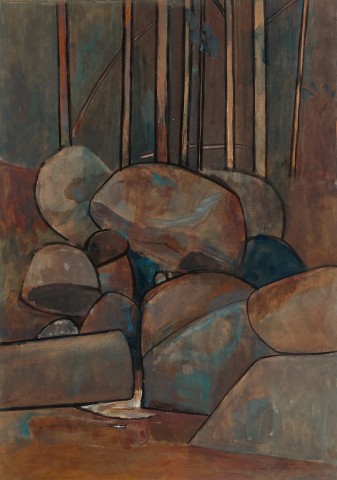ROCKS AND SAPLINGS, 1957 – 58
FRED WILLIAMS
gouache on paper
53.5 x 37.0 cm
signed lower right: Fred Williams.
Private collection
Christie’s, Melbourne, 20 November 1995, lot 203
Private collection, Melbourne
Blue Chip XII: The Collectors’ Exhibition, Niagara Galleries, Melbourne, 2 March - 2 April 2010, cat. 37 (label attached verso and illus. in exhibition catalogue, p. 47)
Landscape with Rocks I, 1957 - 58, oil on composition board, 116.0 x 91.0 cm, in the collection of The Metropolitan Museum of Art, New York, illus. in McCaughey, P., Fred Williams, Murdoch Books, Sydney, 1996, pl. 38, p. 110
Returning to Australia in late 1956 following five years in London, Fred Williams saw the landscape of his own country through new eyes. The vast featureless spaces, undistinguished scrubby bush and harsh light of his homeland offered a distinct contrast to the picturesque English countryside with which he had become familiar. While his friend, John Brack, expressed reservations about the landscape – and particularly the ubiquitous gum tree – as a valid subject for contemporary painting, Williams recognised it as part of a longstanding and respected artistic tradition which was ripe for new interpretation.
Williams visited friends in Mittagong, New South Wales in late 1957 and the subject matter of this work, painted in moody blue and brown tones, connects it to a series of paintings including Landscape with Rocks I, 1957 – 58 (Metropolitan Museum of Art, New York), which was made in response to the surrounding landscape. Gouache, a quick-drying medium composed of watercolour mixed with white pigment (which renders it opaque), was for many years his preferred medium for painting outdoors and as this example shows, in Williams’ hands, it also offered something of the richness of oil paint in terms of the pictorial possibilities and textural manipulation it allowed. The compressed space of the image reveals the influence of the post-Impressionist painter, Paul Cezanne, and hints at the radical distortions of perspective that would follow in Williams’ later work. Similarly, the vertical saplings – with leaning and fallen boughs beyond – point to the increasingly abstract and pared back images of the bush for which he subsequently became renowned.
The decision to concentrate on painting the landscape was momentous for Williams and for the history of Australian art. Capturing its essence, he created archetypal images that have since become part of our collective visual memory, shaping the way we view our country. This singular vision was recognised by the Sydney Morning Herald art critic who, soon after Rocks and Saplings was made, proclaimed, ‘There is every chance he will go down in history as Australia’s greatest landscape artist… Williams clarifies our vision, develops our understanding, defines our land.’1
1. Thornton, W., quoted in Grant, K. & Phipps, J., Fred Williams: The Pilbara Series, exhibition catalogue, National Gallery of Victoria, Melbourne, 2002, p. 17
KIRSTY GRANT
